#gold torc
Text
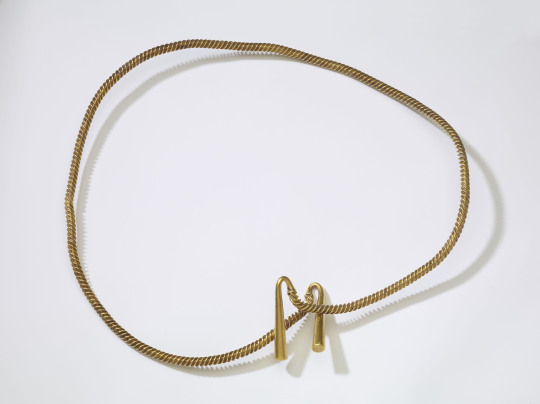

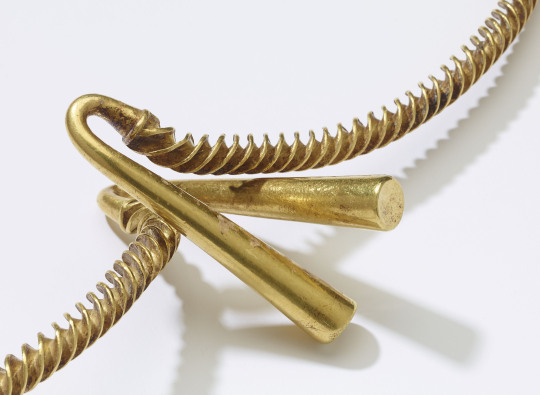
Massive Bronze Age Gold Torc Stolen From Ely Museum
Curators are "devastated" after gold objects dating back 3,000 years to the Bronze Age were stolen from a museum.
A gold torc and a gold bracelet were stolen during a break-in at Ely Museum on Tuesday.
The museum acquired the torc, valued at £220,000, in 2017 using grants and donations and it said the loss was a "huge blow".
Cambridgeshire Police said it was looking for two suspects on e-scooters who were believed to be involved in the burglary.

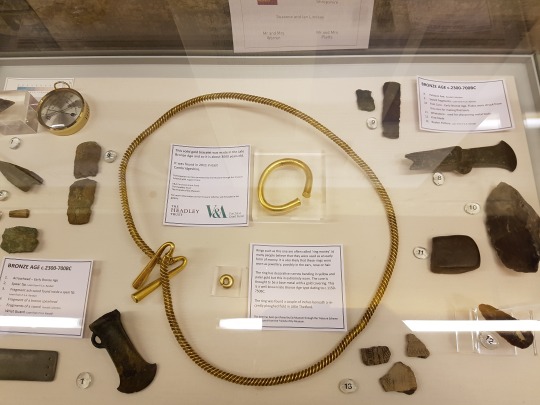
'Cannot be replaced'
Elie Hughes, a museum curator, said: "We are devastated by the loss to the museum and to the local heritage of the region.
"It is a huge blow after the incredible support from the community in acquiring the torc in 2017.
"As a culturally significant object, it cannot be replaced. Our priority now is working with the police to locate the stolen objects."
Both items were found in East Cambridgeshire by metal detectorists.
The torc, found in a ploughed field, is regarded as the best found in England in more than a century as it is larger than many other examples and made of 730g (1lb 10oz) of almost pure gold.
Det Insp Kiri Mazur said: "The theft of these items is despicable and we are focused on identifying the offenders, tracing the items, and returning them to their rightful place.
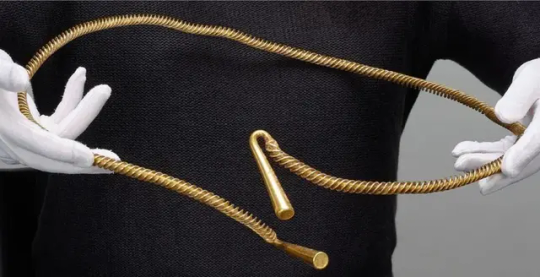
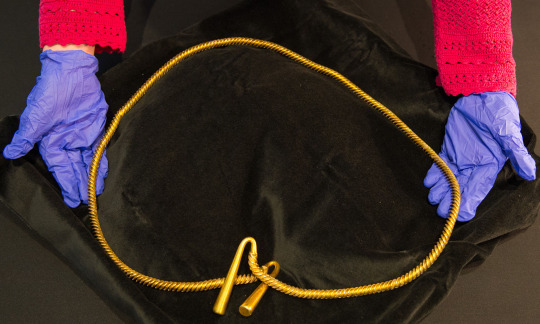
"We are working closely with staff at Ely Museum to follow all lines of inquiry.
“I am very keen to hear from anyone who may be able to provide information or saw two people on e-scooters who were in the vicinity the museum, car park and pedestrian walkways at the back of the museum, the council offices and the Grange Car Park, between 12am and 2am [on Tuesday].”
By Harriet Heywood.
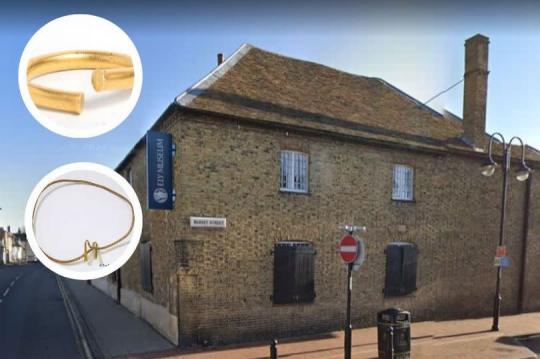
#Massive Bronze Age Gold Torc Stolen From Ely Museum#Ely Museum#gold#gold jewelry#gold torc#gold bracelet#ancient gold#ancient artifacts#metal detecting#stolen#stolen art#looted art#archeology#archeolgst#history#history news#ancient history#ancient culture#ancient civilizations#bronze age#ancient art
26 notes
·
View notes
Text

Iron Age Netherurd Gold Torc Terminal, 1st Century BCE, National Museums Scotland, Edinburgh
This terminal for a gold neck ring and two gold coins are all that remain of a large hoard of gold coins and neck rings found at Netherurd in Peeblesshire. The coins were minted in Gaul in the 1st century BCE, while the terminal fragment is an East Anglian type.
#ice age#stone age#bronze age#iron age#prehistoric#prehistory#neolithic#mesolithic#paleolithic#torc#gaul#celtic#archaeology#ancient crafts#ancient cultures#ancient living#metalwork#gold#wealth#status#Scotland#hoard
199 notes
·
View notes
Text
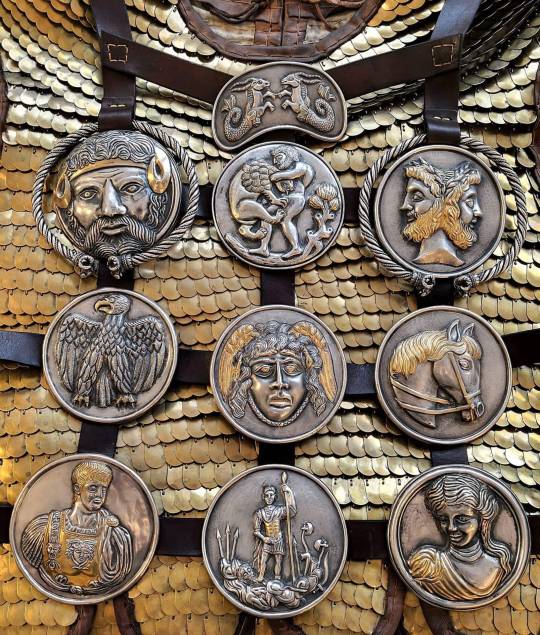
A recreated Centurion's Phalarae harness, 1st Century AD for Legio XXI Rapax. It would be attached to his Lorica Squamata it holds 10 discs for bravery and service. The two discs upper left (the god Jupiter) and far right (god Janus) are attached to two silver torcs, added bravery awards. They could be small or large, gold or silver, flat or heavily 3D to make them more impressive and visible. Between the two top discs is Herac(k)les battling the Nemean Lion and the middle disc is the Gorgon Medusa (common central motif on Roman high officer's Lorica Musculata for hundreds of years) Above Medusa are two mythical Roman Capricorns that are linked to Augustus, and bottom left is the Emperor Nero. The middle bottom is the Emperor Tiberius standing over his dead enemies. Above Nero, appropriately is a mighty Roman Aquila (eagle) spreading its wings - the very essence of Roma herself. This is one of the most perfect harnesses I have seen, not to over the top but it clearly warns all viewers who these men are.
Text by Dan's Roman History
Photo: Cezary Wyszynski
428 notes
·
View notes
Text
Cernunnos Deep Dive
This was a requested deep dive on Hermes, you can request a deep dive on my ko-fi for $5!

Unfortunately not much is known historically about Cernunnos. Scholars seem certain, however, that he was an ancient Gaulish deity.
Let’s get to know this elusive deity!
Parents and Siblings
No attested parents or siblings
Lovers or Partners
No attested partners
Children
No attested children
Epithets
As far as we know, no ancient or historical epithets of Cernunnos have made it through the passage of time. That said, we have some epithets given to him from more modern times.
Lord of Beasts (Anne Ross)
Patron of Prosperity (Anne Ross)
Lord of Animals (Proinsias MacCana)
Lord of Living Beings (David Rankin)
Lord of Beasts and Fecundity (Miranda Green)
The Horned God*
More potential epithets listed in Jess South’s text referenced below.
Keeper of riches
God under the earth
Antlered serpent, Horned serpent
Clearer of paths
Sitter-at-the-crossroads
Sitter-between
Liminal one
God undying
Notes
*In depictions of Cernunnos, his head is notably adorbed with antlers, not horns. This epithet is also the name of the two primary deities of traditional Wicca. It is also shared among many other deities who are depicted with horns.
The name Cernunnos has appeared only once throughout history—on the Pillar of the Boatmen.
Though he is sometimes known as a god of animals or beast, Ceisiwr Serith (or David Fickett-Wilbar) makes the case that although he is depicted on the Gundestrup Cauldron surrounded by animals, only two are looking at Cernunnos, the stag and the dog. Plus there are other deities present on the cauldron.
Cernunnos’ depiction as a “Lord of the Wild” likely comes from his imagery, a man often sitting cross legged and with antlers on his head. This may denote a more spiritual, natural theme for Cernunnos. However, he is not depicted with vegetation or plants
Often depicted wearing a torc, Cernunnos is sometimes considered a god of wealth or fortune. Torcs were known to be a sign of wealth.
He is also seen as a cthonic deity or a psychopomp. Jo Forest makes the case that due to his imagery with snakes—creatures often associated with the underworld—and his relation to the ram due to the ram's horn. Rams were often sacrifices in ancient Indo-European practices.
Cernunnos is likely not a fertility god. This idea may come from his conflation with the Wiccan Horned God, as mentioned earlier.
Cernunnos has been considered to be related to masculinity, but this is also likely due to the conflation with Wicca’s Horned God.
Depictions of Cernunnos with domesticated and prey animals may suggest him being a god of hunting or hunters.
Jess South makes the case further for Cernunnos’ associations with liminality. Between man and animal; hunter and hunted; life and death.
This also points to him possibly being a god of balance or dualities. See Jess South’s “Liminality and Dualities, or “Paired Opposites”’ portion in the text referenced below for more.
Modern Deity Work
Not much is known about Cernunnos or how he was worshipped in the past, but any of the more historically-attested correspondences will have an explanation with them!
Correspondences
Rocks/Stone/Crystals
Gold, silver, copper, iron, and bronze (torcs were made of these metals)
Herbs/Plants
Ferns
Oak
Mushrooms
Mosses
The following plants are associated with liminality, trancework, or hedge-crossing which is why I have included them. Do not consume a plant that you’re unfamiliar with, and be careful touching them. Keep them out of reach of children and pets.
Foxglove
Mugwort
Nightshades
Animals
Stag (depicted looking at him on the Gundestrup cauldron and the silver bowl from Lyons, also he is often depicted with antlers like a stag)
Dog (depicted looking at him on the Gundestrup cauldron and the silver bowl from Lyons)
Ram-horned snake (often depicted holding a snake)
Symbols
Torc (often depicted wearing and holding torcs)
Snake
Antlers
Offerings
Torcs
Imagery of the animals associated with him
Wine
Beer
Antlers
Food
Bones
Feathers
Coins
Acts of Devotion
Explore liminality--what this means is up to you!
Take time to appreciate the balance between man and nature, see how you can participate.
Go hunting--this isn't required but if you're up for it, go for it! Just make sure to do so in an ethical way.
Meditate in the forest, or forest bathe, or just hang out in a woodsy /natural area
Quite frankly, since he is a god heavily associated with liminality, it may be a good idea to test the waters with gender expression!
Read up on him, the following section has a lot of really interesting takes and history on Cernunnos!
Get into cthonic magic
Consider learning more about hedge witchery
References and Further Reading
Cernunnos; An In-Depth Look by Jo Forest
Cernunnos: Origin and Transformation of a Celtic Divinity
Cernunnos: Looking a Different Way by David Fickett-Wilbar
Not Your Mother’s Horned God: The Cernunnos Primer by Jess South (“thebloodybones”)
Britannica
Wikipedia
Mythopedia
ΚΑΡΝΟΝΟΥ: to CARNONOS
95 notes
·
View notes
Text
Captive, Captivating
into the steddie-verse, omegaverse, intense dubcon, we’re all in the same imperial rome/war prize gutter together, mdni 🔞
As the emperor’s brother, Geta should not be on this northern campaign, but he is curious of these barbarians and how they live without the bounty of the mediterranean. His tent is rather well-appointed besides, his own personal guard and servants setting up his bed, the furs and chairs, each time they move. He even has a small brazier to heat the tent against the cold night.
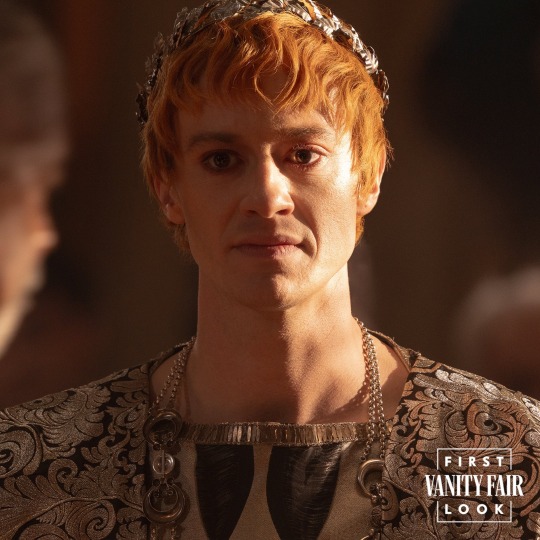
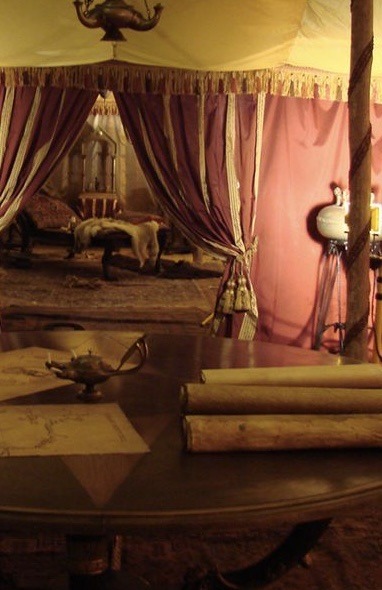
That doesn’t make his presence anymore reasonable, but as the only member of the imperial family amongst the generals and their legions, it means the greatest of the war prizes belong to him. Thus far, he has accumulated a beautifully made brooch inlaid with garnets, several gold torcs, a pair of fine horses, and one prince to ransom back to his father—that netted him gold and silver coins from many kingdoms, as well as a herd of goats.
But there hasn’t been anything new for weeks, and Geta thinks they are perhaps between barbarian kingdoms. The sun has set on another day, and he is reading over the report he is about to send back to Rome, when Junius enters the tent and makes his presence known.
“We’ve captured an intruder, your grace. Flavianus sniffed him out, and it sounds like his father is a king. Ricardius Spear-hand, if he’s to be believed.”
“And just what was the little prince up to?” Geta puts down his report, grinning. This is intriguing.
“Spilling wine urns and turning loose horses. But mostly spying. We found him outside the general’s tent. The fool rubbed himself in wild mint, but it wasn’t enough to dampen an omega’s scent.”
Geta burns hot at that, his own smoky scent blooming. He has questions, but more than that, he wants to meet this bold omega prince. “Bring him to me.”
“At once, your grace.”
Junius is barely gone a minute, clearly anticipating this request, bringing in a growling young man, stripped down to a loincloth to ensure he carries no weapons, his hands bound in front of him. His flesh is raised in a thousand tiny bumps at the chill of the night air, and his thick, dark hair hangs limp around his head, stringy with his own drying sweat. And his scent is sweet and yeasty like the honey beer the northern barbarians drink in place of wine.
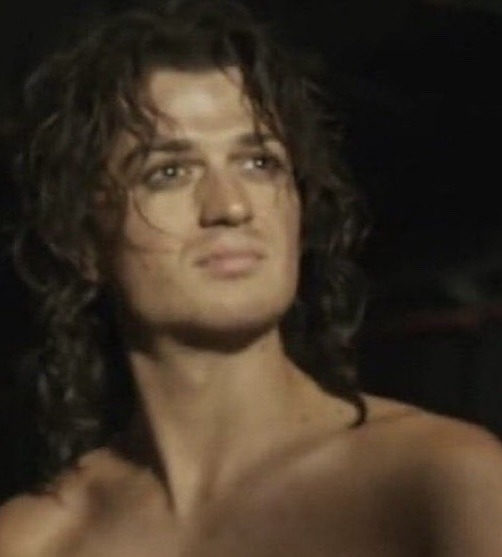
“He claims to be Prince Stephanos, your grace. I don’t believe we have record that he’s an omega… Other than this.”
“Why do you insist upon changing my name?” the omega asks, voice harsh with his whining little growl. Geta has heard of northerners learning Latin, but he did not expect this prince to speak it so well.
“You are Stephanos, son of Ricardius, are you not?”
The boy frowns, looks away, and waits. Junius raises a questioning brow, which Geta answers with a wave of his hand and a soft, “Leave us.”
Junius bows and backs out of the tent.
Stepping closer, Geta grips the omega by the chin, and turns his head to face him. “I asked you a question, little prince.”
His hazel eyes flash with defiance, and he bites his lip so hard it bleeds. Then he takes a breath. “I am Stepan, son of Rikhardt Spear-Handed. As my father’s eldest child, I did my duty. Please, take your soldiers and leave my people be.”
Swiping his thumb over Stepan’s lip, smearing the blood, Geta wants so badly to taste. To bite. He resists, leaning in closer and whispering, “I am not here to conquer; that is my brother’s doing. I wish only to learn and see and experience what this world has to offer. I will be your willing student, sweet Stepan, but I shall also be your master. You have bought freedom for your people.” He withdraws his thumb and sucks it into his mouth, the metallic taste of blood on his tongue, yet somehow sweeter than he expects.
The omega trembles, and Geta steps back to hive him space, eyes roving over his exposed body. His nipples are hard, pebbled along with his gooseflesh, and his small breasts are puffy, swollen like he’s near his heat.
“I will not take you tonight, so do not fear.” Geta circles him slowly, retrieving a length of soft, woven wool, and steps up behind him, arms wrapping the cloth around the omega’s shoulders. Stepan jolts at the touch, but doesn’t struggle as Geta holds him. “But you will be mine.” His right hand settles low on Stepan’s belly, presses firm. “Soon my pup will be here.” He sets his nose to the princeling’s neck, and Geta is sure he smells even sweeter as he inhales deeply. “Can tell your heat is coming, but maybe you’ll breed true before it can begin.”
He drops a single kiss over the warmth of Stepan’s mating gland, feels the flutter of his pulse. “But tonight we shall simply rest. Come, Stepan. Let’s to bed.”
🏛️🌙🌿
Stepan does not sleep that night, or if he does, it is a fitful sleep. But he has no hope of escape, his captor holding him tight from behind, trapping him in the bed beneath sheets softer than he has ever felt. And surely, the tent is well guarded.
He’s spent enough time awake, looking around the tent for anything he can use, either to incapacitate the roman, or if worst comes to worst…
He hopes it does not come to that.
Strong arms squeeze around his middle, a forehead presses into his shoulder, as the alpha wakes with a sighing hum. “Good morning, little prince.”
The mere thought of replying cordially locks his throat, but Stepan swallows and decides to get it over with; the words will only get easier with practice. “Did you sleep well, Dominus?”
“Best I’ve slept since coming north. How you can sleep in this cold I’ll never understand.”
“It is summer, Dominus?” How soft the romans must be to find a summer night cold. He wonders how his new master would handle traveling through the snow in winter.
“Yes, summer! The air should be hot and leave your skin sticky long after the sun sets!” His hold on Stepan changes, no longer a harsh grip, but one arm loose around his waist, the other snaking up so his hand cups one of Stepan’s breasts. “This is the first time I haven’t woken shivering.” He squeezes, kneading the soft flesh beneath his fingers, then pulls back just enough to grip the nipple between finger and thumb.
He pinches and pulls, and Stepan hates that it feels good. Stifling a moan, he brings his still loosely-bound hands up to grab the alpha’s wrist. “Dominus?”
“You are just so sweet and so warm,” he growls low in Stepan’s ear. Hand spread wide across his chest, moving with each shallow breath, he changes course. No orders to get on his hands and knees, no spreading of his legs, no hand pushing aside the cloth over his sex. Instead, he murmurs, “We shall meet with your father and his counsel today, to talk the terms of peace.”
“The terms being me. In your bed.”
“The terms being you. At my side. I am not looking for a mere bedwarmer, sweet Stepan.” He contradicts this entirely by kissing the side of his neck, sucking the salt from his skin. “You took a risk. It failed you, but now you have learned. And with my guidance you will learn more.”
Stepan’s mind races. He had been certain thot at best he would be a concubine; an omega to give this roman enough bastards to feel good about his virility when his high-born wife managed a sickly pup or two. He no longer thinks that is what his master has in mind. “Dominus?” he asks softly, wishing he could see his eyes now, even in the low light it would tell him more of what he means.
“Rome is a dangerous place. You and I shall need all our cunning when the army returns at the end of this campaign.” He relaxes his grip, finally, and rolls away just enough to make room for Stepan to roll onto his back.
His master smiles, wolf-like, and places a hand back over Stepan’s breastbone, holding him down with the lightest touch as he stares into his eyes. “Do not worry, my sweet omega, I’ll do everything in my power to protect you and our pups.”
“What pups, Dominus? We have done nothing to make any.” Stepan shivers under his dark gaze. “Besides, how can you be certain you won’t grow bored with me in a month’s time?”
“It will take far more than a month to do everything I want with you. Do not worry about my growing bored.” He leans down and takes a dusky nipple into his mouth, biting at the bud with gentled teeth.
Stepan pants, watches as the alpha removes his mouth, tongue lapping at tender skin. A hand reaches for his, working him free from the soft bonds at his wrists and casting the fabric aside. “But you are right; we’ve done nothing to make pups.” He reaches for the ties at Stepan’s waist, pulls them loose, and pushes the fabric aside. “We ought to get started now.”
He pushes off his own coverings, but Stepan does not look. If he doesn’t look, his body cannot lock up at the thought of the intrusion. He can relax enough to keep it from hurting. To keep from being torn apart.
His master has other plans for their coupling, catching up Stepan’s hand and wrapping it around the alpha’s half-hard cock. He guides Stepan in rubbing him to full hardness, tiny moans and soft praise falling from his lips, breath hot against his skin. “Good omega. Yes, touch just like that.”
Finally ready, he boxes Stepan in with his arms, and ruts first against his cunt, just enough wetness there to ease his way and coat his cock. “Even scared you smell so sweet,” he whispers, dipping to nose at his mating gland. “So sweet.” He shifts his hips, and the head of his cock nudges against Stepan’s entrance. He only waits a moment, long enough to whisper, “Deep breaths, my omega,” before thrusting forward.
Stepan gasps, is sure he is being split apart, and moans, “Dominus, please…”
“It will only hurt a little while. Your body will learn.” He stays buried inside, watching Stepan breathe, waiting for him to calm. Only then does he move his hips, picking up speed until he spills hot, his knot tying them fast.
Gathering Stepan to him, he rolls onto his side and holds him close, bringing one of Stepan’s legs over his hip, which opens his cunt enough to relieve a little bit of the pressure there. “Rest, my sweet. Once we untie, we shall bathe and eat. Then this afternoon we shall treat with your father.”
Stepan nods. He has done his duty. His people shall have peace.
part 2
#omegaverse#fanfiction#ficlet#steddie#not really but still steddie#gladiator 2#alpha geta#omega war prize steve
56 notes
·
View notes
Text

Celtic Gold Phalera with Cernunnos, 1st Century BC
Cernunnos is the conventional name given in Celtic studies to depictions of the “horned god” of Celtic polytheism. The name itself is only attested once, on the 1st-century Pillar of the Boatmen, but depictions of a horned or antlered figure, often seated cross-legged and often associated with animals and holding or wearing torcs, are known from other instances.
Nothing is known about the god from literary sources, and details about his name, his cult or his significance in Celtic religion are unknown. Speculative interpretations.
52 notes
·
View notes
Text
Fern's Cernunnos Deep Dive pt. 2

Aspects
Animals
The most obvious on here is of course Cernunnos' antlers. It ties him to the stag, and through this to the realm of animals. However, this is not the only evidence we have. Most who have written about Cernunnos, like Green, Ross, MacCana, and Strutynski, all name him "Lord of Beasts" or a variation on this theme. On the Gundestrup Cauldron, one of the most iconic images we have of Cernunnos, he is surrounded by animals. The depiction found of him in Reims show a rat on his antlers, and a stag and bull at his feet.
Forest and Hunting
From the depiction of animals, especially those of the stag and the boar, it is a natural step to associate Cernunnos with the forest. The stag is known in different European cultures as the King of the Forest, so an antlered God being a Lord of King of the forests and all that lives within, makes sense. On the Grundestup Cauldron we see prey animals, such as the stag, the fish, and the bull. As well as animals used for hunting, like the dog. This had lead many to believe that he is also the God of the Hunt, and even, through an admittedly flimsy connection with Herne, as the leader of the Wild Hunt. David Fickett-Willbar posits that there is not enough evidence of actual hunting to support Cernunnos as a Lord of the Hunt. On none of the depictions there are actual hunting attributes seen, only the dog, which in Celtic and Gallo-Roman depictions more often symbolized the underworld or Otherworld than hunting. That being said, in my experience Cernunnos is definitely a God of the hunt, being both the stag (the hunted) and the wolf (the hunter).
Cycle of Life and Death
Because of his aspect of both Hunter and Hunted, and his tie to animals, I also associate him with the cycle of life and death. Birth, to adulthood, to death, to decay, to rebirth. The cycle of nature, in animal and in plant life. A thing that is easy to observe in the deep forests.
Chthonic God
This ties into the cyclic aspect of life, but there are more things that tie Cernunnos to "within the earth" or the Underworld. He is often depicted with a horned serpent, which according to Marian Green depicts the calm nature of Cernunnos. However, in Greek myth we also have a ram-horned serpent called the Cerastes. This serpent would burrow itself within the earth, until only the two (or four) horns were visible. There it would wait for its prey to come by, leap out, and devour it. Because of the burrowing the Cerastes, and through it the horned serpent, are also tied to the Underworld, to which it was thought he was closer.
The dog or hound is also often found on images of Cernunnos. Not just a symbol of the Hunt, the dog was also a symbol of the Underworld in the Germanic world.
Wealth
Another attribute that is carried often by Cernunnos is the torc. A torc is a neck ring, often made from bronze or gold. It is seen as a symbol of status, of divinity, and of material wealth. Later the torc was replaced with a bag of bowl of coins, another symbol of material wealth. Oxen were also a sign of wealth that appear on Cernunnos' engravings, also tying him to the wealth of towns and agriculture, rather than the forests. This is an aspect of Cernunnos that does not appear to me often, personally, but I do see the association.
Liminality
The liminal, the in between. Often we see Cernunnos depicted with a horned snake in his left hand, the snake meaning death and the left hand having negative connotations, and the torc in his right hand, the torc meaning wealth and the right hand a positive sign. Cernunnos places himself in the center by holding his hands at shoulder height. On the depiction of Cernunnos found in Reims we see the stag and the bull. Both symbols of wealth, but where cattle is a sign of domesticated wealth, the stag is a sign of the wealth of the wild. And once again, Cernunnos is depicted in the center. On the Grundestup Cauldron there are dogs, a sign of the hunter and death, and stag, a sign of the hunted and life, opposite of each other, both facing Cernunnos. Which brings us to the tricephalous, a Gaulic representation that is found for several Gods, amongst which Cernunnos. It is a figure with three heads, one facing forward, and the others facing to away from the center to the sides. Many interpretations can be made about facing the past and the future, death and life, the negative and the positive. But all places the center head, which is often most detailed or bigger than the others, in a more important position. Two statues of Cernunnos found in Atun and Condat, both are tricephalous and have removable antlers.
On a personal note have also experienced Cernunnos as liminal when it comes to gender. He has helped me see my own liminality, and I often see him with different mixes of primary and secondary sex characteristics. Other non-binary devotees of Cernunnos have expressed similar experiences.
And with that we have reached UPG territory. The next ones are purely from my personal experience with Cernunnos, and, as far as I know, have no basis in the historic evidence that has been found.
the Otherworld
To me, Cernunnos is also a King of the Fae. The deep wild woods are reminiscent to the realm of the Wild Fae, and often entrances to this realm can be found there. As said above I associate him with the Wild Hunt, a procession of beings racing through the skies at certain times of the year. Sometimes these are beasts, sometimes these are fae, and sometimes these are witches. (Perchta's procession is children, but that is specific to her.)
In the path that I walk witches and fae are very closely related, and through this Cernunnos is also seen as the Witch King. Teaching magic and journeying to and from other realms.
Bonfires
Another personal association. To me Cernunnos is closely tied to music, and to ecstatic dance, often around a bonfire. I have had several instances of dancing in front of a fire, and suddenly seeing myself on top of a mountain, a huge bonfire in front of me, and other witches and devotees sharing this moment of dance and passion. There is also the Dutch festival of Castlefest, which is a pagan- and fantasy festival. On Saturday they burn a wicker creature, which holds offerings made by the visitors. My offering is always for Cernunnos, whose presence I feel strongly at this festival. So this is another reason for this personal association.
[Masterpost]
30 notes
·
View notes
Text


Scythian Gold Double Dragon Torc Necklace from Central Asia (200 BC).
"After extending their country Scythia into more western lands beyond the Black Sea, many Scythians migrated into Europe and the Middle Eastern lands as far as Egypt while leaving new Dragon Families and Courts in their wake. The various tribes of Scythians included the Royal Scythians as well as the Ossetians, Pashtuns, Sarmatians, Kazakhs and Yakuts. Once in Europe, these Scythian tribes spread over much of their new continent, eventually separating into the Hungarians, Romanians, the Serbians, the Croatians of the south, as well as the Germans, Picts and Gaels of the north."
From Mark Amaru Pinkham's "An Initiates Guide to the Path of the Dragon
64 notes
·
View notes
Text

lietukr au but this time i was inspired to draw olga with some of traditional ukrainian accessories. below i tried to shortly summarize what they are so give it a read🫶
sýlianka (силянка, also pletínky/плетінки) - neck ornament made out of seed beads of various colors stringed in rows to create geometrical and floral patterns. also very similar to syliankas are gerdán and kryza
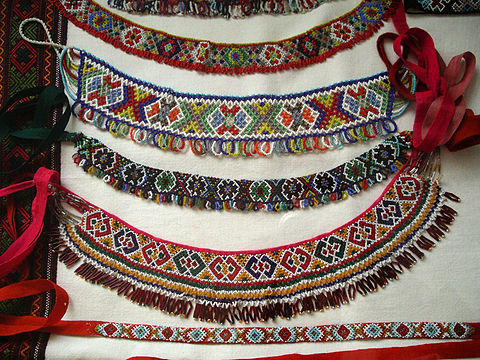
koráli (коралі, or simply corals) - a necklace made out of coral beads, the amount of rows could be anywhere from 1 to more than 25. korali are a traditional element of the national ukrainian costume. a larger amount of rows oftentimes signified of the family's wealth


zgárda (зґарда) - a religious accessory typically of people of high status. zgardas men and women wore were different. the ones women wore were crosses out of copper or brass stringed in several rows with small spirals or tubes between them. men's zgardas were typically worn on torcs or straps


balamuty (баламути) - a necklace made with nacre beads. it was considered an expensive accessory, so it was mostly worn on weddings and was inherited by a daughter from her mother. also a traditional element of the ukrainian costume.

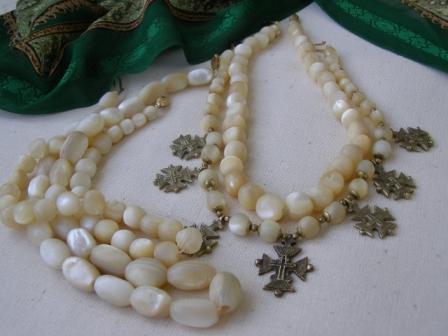
dukáty (дукати) - metal coins or medallions made into a necklace. the necklace often included beads, coral beads and crosses. sometimes made out of real gold and silver coins.

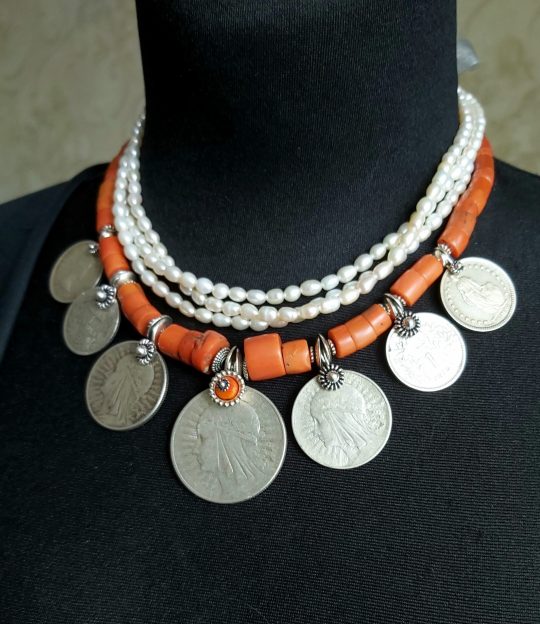
74 notes
·
View notes
Text
Elder ᚠᚱᛖᛁᛃᚨ Younger ᚠᚱᛁᛁᛁᛅ
Freyja/Frøya (The Lady)
Epithets And Titles
Gullveig (gold-greed) Her more magical and ruthless side is closely associated with fire due to her being burned but not harmed
Vanadis (lady of the Vanir) Her neural side has a little bit of all her aspects and is what you normally call on
Gefn (giver) Her motherly giving side associated with fertility and harvests etc
Horn (flax) Her side associated with Love, sex, and playfulness
Mardoll (root word Marr meaning sea. Sea bright) One of her sides associated with death and war
Syr (sow)
Valfreyja (Lady of the Slain) Another side associated with Death and War
Lady of fire
Heid (Völva from Voluspa)
Thrung
Lady of the Disir
Skialf
Queen of Folkvangr
Chief of the Vanir
Queen of the valkyrie
Possessor of the fallen
Ruling/Domain
Folkvangr is her realm and Sessrumnir is her hall.
(and is sometimes said to be where she takes her half of the dead but this is disputed)
Family
Njord is her father and her mother is never mentioned but is speculated to be Skadi or Njords sister, an unnamed Vanir goddess. Her twin is Frey(r). She has 2 daughters Hnoss and Gersemi both of which translate to "treasure" though only mentioned in Christian sources and Gersemi is only mentioned once. In the Eddas, it says she has a husband named Oðr which is one of Odin's names, and gets into the Frigga and Freyja debate.
History
I won't get too much into the debate on her and Frigga but by the myths, they are different and separate beings. Historically they were possibly the same once and split over time but they are not the same now.
Frøya has a necklace she always wears. Its name is Brisgamen is a torc/necklace made by the dwarves and frøya supposedly spent a night with each of them who made it to get Brisingamen. In other myths Thor wears it dressed as Frøya during the fake wedding to Thrym the giant who stole Thor's hammer, then when Loki stole it and gave it to Odin when Odin made her start a war to get it back.
She also had a Boar named Hildisvini "Battle-swine" which she turned her husband oðr into and rode in one of the myths.
In the Grimnismal translation, it says "then" Odin picks not "and" giving the idea Freyja picks first but it's never mentioned otherwise. But modernly we accept that she does have the first pick.
Gullveig is believed to be another name for frøya she was a sorceress who predicted the Æsir, Vanir war and was burned alive 3 times by the Æsir each time coming back to life and was struck by spears and still didn't die.
She, like Odin, was known to use many different names throughout the myths and in her travels.
She's the one who taught Odin and the other Æsir gods how to do Seidr magic.
After the Æsir, Vanir war they exchanged hostages, and Frøya, Njordh, and Frey went to live with the Æsir in Asgard.
It's rumored but never confirmed if Freyr and Freyja have Elven ancestors. But she is NOT a valkyrie; the only sources with that are later Christian sources; this is believed to be the same thing as making her out to be a love goddess and sexualizing her.
The myths never actually show her as a Vølva but her association with magic gives us the idea she is.
She also had a chariot that was pulled by cats sometimes people believe they’re Lynx.
Historical worship/practice
She had a fertility cult in the Viking age that stopped due to Christianity and a cult that lasted up until Snorri's age and time but that stopped soon after. She and Frigga were called on during childbirth, historically our source coming from a midwife.
Associations
Death
Love
Lust
Magic (especially Seidr)
War
Cats
Wealth
Divination
Fertility
Beauty
Glory
Days of the Week
Friday
Special days
Alfarblót (The first day of winter celebrated in the home in private the time when we connect to ancestral magic to the Elven folk)
Elements
Fire
Numbers
9
Colors
Gold (fav)
Light Pink
Green (fav)
Copper
Silver
Yellow
Light Purple
Red
Brown
Planet
The Moon
Animals
Cats
Horses
Boar/Sows
Rabbits
Swallows
Lynx
Falcons/Birds of prey
Ladybugs
Cuckoo
Plants
And flowers
Basil
Roses
Roseroot
Common Valerian
Mugwort
Rosemary
Apples
Primrose
Raspberries
Strawberries
Cinnamon
Poppy's
Daisy's
Almonds
Hay
Snow Blossoms
Linden
Essential oils/incense
Strawberry
Lavender
Lilac
Juniper
Cinnamon
Any sweet scents
Any baked good scents
Amber
Mint
Peppermint
Rose
Mulberry
Rosemary
Vanilla
Jasmine
Cypress
Sandalwood
Myrrh
Birch
Crystals
Rose quartz
Amber
Gold
Carnelian
Citrine
Any moonstone
Malachite
Black Tourmaline
Pink Tourmaline
River rock
Rubies
Divinational associations (runes/tarot)
Fehu, Sowilo, Berkano, Queen of wands, Queen of swords, The empress, The high priestess, The lovers, The star (Wildwood deck The Seer, and The Woodward)
Offerings and Devotional acts
Any Meads
Flowers (pressed or fresh)
Anything handmade for her
Stretching
Learning sword work
Exercising
Things respectfully taken from nature
Jewelry
Poetry (especially traditional Norse)
Hot coco
Any tea
Wine
Sweet drinks or spice like cinnamon
Potatoes
Stews
Any meats
Any Berries
Ethically gathered Bones, Cat claws, and cat whiskers (DO NOT HARM AN ANIMAL FOR THESE)
Self-Care
Spending time in nature
Learning runes
Learning distaff spinning
Any imagery associated with her
Learning magic or divination
Any baked goods (bread, muffins, honey cakes, etc)
Honey
Honeycomb
Cat statues
Boar imagery
Fostering cats/kittens
Lighting candles every day in her honor
Burning incense for her (she likes things with flames or burning)
Bonfires
Flax bundles
A staff making a staff for your craft if you practice Seidr they are commonly used in it and you could make your devotional staff for that and have it by her alter.
Alter Suggestions
Candles
Bones
Jewelry (especially gold-colored)
Statues of her or her cats
Swords/axes/spears/shields
Wooden bowls or horn bowls
Incense
Plants
Imagery of Folkvangr
Dedicated Poems about her or love or death
The artwork you make her
Animal pelts
Runes
Fehu imagery
Chants
Runic Chants/chanting the runes
Old Norse songs
(Both are commonly used in seidr)
Signs they may be reaching out
Smelling scents associated with her out of nowhere
Seeing her in dreams and meditations
Becoming more attracted to colors associated with her
Being closer to Cats or cats favoring you a lot or having different behaviors toward you
Views over death and war changed drastically
Having potential in Seidr magic
Being a seer/seeress
Being open to the spirit realm and the dead and speaking to them
Having a very sudden interest in her
Feeling a very feminine energy and string energy in the room (she's not subtle at all)
Liking foods associated with her that you didn't before
Sudden interest in distaff or spindling.
SOURCES
Freyja, Lady, Vanadis: An Introduction to the Goddess
by Patricia M. Lafayllve
Poetic Edda translated by Jackson Crawford
Tales of Norse Mythology by Helen A. Guerber
The Norse Gods and Goddesses (Intro.)
Frigg and Freyja
The Vanir
The Vǫlva (Norse Seeress) and Seiðr
Valkyries (Valkyrjur)
Fólkvangr (Folkvang)
THE NORSE GODS: FREYJA || General info, what working with Freyja is like and offerings
Freyja (Freya) Norse Goddess of Love, Warriors, and Cats
My Experiences with Deities: Freyja
Seiðr Magic and Gender
https://teaandrosemary.com/freya-goddess/
https://study.com/academy/lesson/goddess-freyja-facts-symbols-norse-mythology.html
https://historycooperative.org/freyja-the-norse-goddess-of-love/
https://historiska.se/norse-mythology/freyja-en/
https://hrafnar.org/articles/dpaxson/asynjur/freyja/
https://www.britannica.com/topic/Freyja
https://www.northvegr.org/nordic-goddess/froya-freyja
https://www.spiritualityhealth.com/freyja-sensuality

#witchcraft#witchythings#beginner witch#witchyvibes#witchblr#witch community#paganblr#paganism#pagan witch#pagan community#norse runes#norse mythology#norse paganism#norse goddess#freyja#goddess freyja#cats#cats of tumblr#seidr#norse magic#crystals#herbalism#study notes#studyblr#study blog#norse pantheon#norse gods#nordic#lunar magic#deity work
118 notes
·
View notes
Text

A recreated Centurion's Phalarae harness attached to his Lorica Squamata it holds 10 discs for bravery and service. The two discs upper left (the god Jupiter Amon) and far right (god Janus) are attached to two silver torcs, added bravery awads. Centurions often affixed their military Paludamentum to these to high light that he had two of the prized awards, they could be small or large, gold or silver. Between the two top discs is Herac(k)les battling the Nemean Lion and the middle disc is the Gorgon Medusa (common central motif on Roman high officer's Lorica Musculata for hundreds of years) Above Medusa are two mythical Roman Capricorns that are linked to Augustus and bottom left is the Emperor Nero. The middle bottom is the Emperor Tiberius standing over his dead enemies. Above Nero, appropriately is a mighty Roman Aquila (eagle) spreading its wings - a symbol of Rome itself.
This was a very decorated group of 80 staunch warriors led by two seasoned, elite officers in the Optio and his commander, the Centurio. Exemplary on the battlefield to have been awarded all of these medals." The Mighty XXI" apart from being a walking "shing trophy case" of crazy bravery, it also oozes blatant propaganda, it positively dribbles with thematic Roman values: honoritas, gravitas, dignitas and nobilitas. When the Centurio or Optio weren't wearing it, one of the elite standard bearers was able to done it, an absolute honour in itself.
Image: Cezary Wyszynski Legio XXI Rapax.
151 notes
·
View notes
Note
Ainda sem entender pq essas gringas aqui estão bravas chega até ser engraçado. Tem uma querida que comenta sobre o barça e a seleção espanhola que não reconhece o quanto elas foram péssimas 😂
O time delas jogo o pior futebol, as jogadoras da espanha falam um monte de merda depois da partida e a gente tem que aguentar calado? Ah me poupe, esses europeus sempre se achando superior às seleções sul-americanas...
Bom, há quem diga que a negação é um dos primeiros estágios do luto.
Mais cedo eu vi uma coisa no Twitter que pra mim fez muito sentido, vou tentar resumir aqui.
Enquanto nós estávamos em uma má fase (literalmente semanas atrás) correndo risco de ficar fora dos Jogos Olímpicos, ou até mesmo no começo do ano quando disputamos a Gold Cup e a She Belives lá nos EUA e apesar de apresentar um bom futebol ainda saímos perdendo, todo mundo gostava da gente. Era sempre o mesmo papo de: "Ah, o Brasil merece mais!", "A Marta merece encerrar a carreira internacional com um título", "É triste ver a atual fase da Seleção Brasileira", etc, etc.
Mas agora que aparentemente encontramos o nosso futebol e apesar de eu discordar com algumas coisas (tal como a cera excessiva da Lorena pro Arthur arrumar a bagunça no campo) e principalmente depois de derrotar essas duas grandes potências do futebol feminino, o papo é outro, que nós jogamos sujo, que não jogamos futebol, como a Hermoso falou, que somos arrogantes, desrespeitosas, antidesportivas, e por aí vai.
Esse tipo de gente não entende a verdadeira essência do futebol, o quanto ele impacta de verdade não só a vida das jogadoras que vestem as nossas cores, mas a vida de quem torce, de quem tá conhecendo agora, das meninas e meninos que sonham em jogar futebol profissionalmente. Como os momentos de gritaria e provocação em campo são um desabafo, uma resposta a quem duvidou, desdenhou e até mesmo provocou elas anteriormente.
E se você parar para pensar, não é muito diferente do que rolou com a Argentina na Copa de 2022.
(Sim, a situação tá tão feia que eu vou ter que sair em defesa dos hermanos)
Apesar de tudo, eles se mostraram obviamente superiores às demais equipes naquela Copa, fizeram a maior final de uma Copa do Mundo (pelo menos a melhor que meus olhos viram nos meus quase 20 anos de vida), ganharam merecidamente nos pênaltis e lembraram o mundo de uma coisa: Se não fosse a América do Sul, o futebol não seria aquilo que ele é hoje. Se não fosse pelos nossos jogadores saírem daqui para jogar em times europeus, o futebol jogado por eles não teria relevância ou prestígio algum porque tudo começou aqui, as rivalidades começaram aqui. Eles podem até ter inventado o futebol, mas quem sempre soube jogar ele de verdade fomos nós. O primeiro campeão da Copa do Mundo foi o Uruguai, o maior campeão é o Brasil e o último campeão é a Argentina e nos ver em campo incomoda tanto eles porquê os lembra da verdade, no final das contas, é tudo nosso.
Criticaram o Dibu Martínez pelas provocações e os atos soberbos dele na Copa, hoje criticaram as meninas do Brasil por vencerem e mostrarem força de vontade em campo.
Não sou a pessoa mais religiosa do mundo, mas concordo com algo que a Lorena falou na entrevista pós-jogo para a CazéTV, nem tudo acontece quando e como a gente quer, nada é no nosso tempo, mas sim no tempo de Deus. O amanhã só a ele pertence.
Apesar de tudo é muito importante que a gente mantenha os dois pés no chão para essa final e o mais importante de tudo, não dê bola para as opiniões alheias, por mais absurdas e incômodas que elas possam ser. No final das contas vai ser só mais uma entre tantas que já vieram e das inúmeras que ainda estão por vir.
17 notes
·
View notes
Text

Blair Drummond Iron Age Hoard, Gold Torc (with a hoop of twisted wires, its terminals decorated with filigree and granulation), 3rd to 1st Century BCE, National Museums Scotland, Edinburgh
#ice age#stone age#bronze age#iron age#prehistoric#prehistory#neolithic#mesolithic#paleolithic#iron age living#metalwork#metalworking#torc#celtic#celt#jewellery#gold#filigree#archaeology#ancient cultures#ancient living#Scotland
92 notes
·
View notes
Text
I had two days of from work and managed to visit my local Gallo-Roman museum (the name is actually deceiving as they focus on the area between Neanderthals and Merovingians). Here are some of the things I saw!



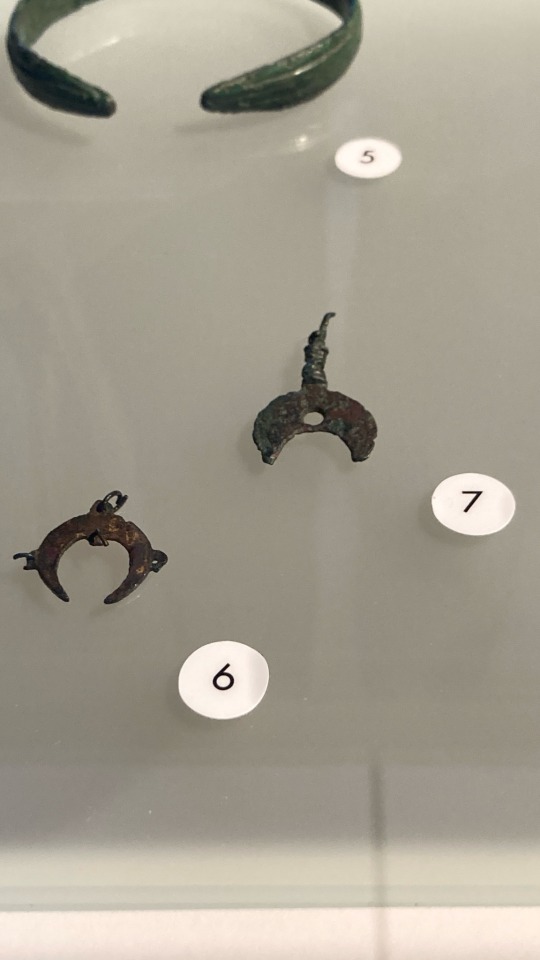


1) Gallic Torcs in gold
2) a complete Dodecahedron in bronze
3) Late Roman dress pins in bronze
4) Lunulae, moon shaped pendants, generally believed to be a lucky charm
5) a Merovingian bucket, a funerary gift
6) late Roman keys in iron
#frankish#merovingian#viking archaeology#archaeology#carolingian#charlemagne#field archaeology#viking mythology#merovingian archaeology#germanic mythology#roman archaeology#rome#ancient rome#western Roman Empire#ravenna#Gaul#gaulois#Celtic#Hallstatt#norse mythology#anglo saxon#viking#field archaeologist#frisian#odin#vikings#germanic#germanic folklore#germanic archaeology
20 notes
·
View notes
Text

Scythian gold torque in the form of dragons, dated to the 2nd century BC to the 1st century AD.
Hundreds of tiny scales are individually soldered to the writhing forms of two confronted dragons on this magnificent gold torc. Thick curving horns sweep back over the long pointed ears of the rather wolf-like dragon heads. With muzzles drawn into ferocious snarls, these mighty beasts express the formidable strength of the Scythians, one of ancient Eurasia’s most powerful cultures.
19 notes
·
View notes
Text
ADDAM + HUGH
The way GRRM wrote these 2 dragonseeds, it's apparent they are meant to be contrasted against each other. With other dragonseeds, like Ulf, he exists as a sidekick to Hugh and someone who tries to take up Hugh's mantle after his death, so we don't even get much of a description of what he's truly like. Ulf's role in the story is more about having a presence as one of the betrayers so that the 2 Treasons plot can have urgency. Ulf is to Hugh what Alyn is to Addam. And because of that contrast, obviously Alyn is a character with much greater importance than Ulf. Nettles stands apart from the rest of the dragonseeds which is why her story takes a different turn at the end. With Addam and Hugh specifically though, they are narrative foils.
SMALL & QUICK VS TALL & STRONG
Small and quick as their mother, these bastards of Hull were both silver of hair and purple of eye, and soon proved to have “sea salt in their blood” as well, growing up in their grandsire’s shipyard and going to sea as ship’s boys before the age of eight.
— Fire & Blood, The Dying of the Dragons: The Red Dragon and the Gold
The son of a common blacksmith, Hammer was a huge man, with hands so strong that he was said to be able to twist steel bars into torcs. Though largely untrained in the art of war, his size and strength made him a fearsome foe.
— Fire & Blood, The Dying of the Dragons: Rhaenyra Triumphant
SECRETIVE VS BOASTFUL
And Addam Velaryon, lately Addam of Hull, sought out the Sea Snake after the battle; what they spoke to each other even Mushroom does not say.
— Fire & Blood, The Dying of the Dragons: The Red Dragon and the Gold
Mushroom tells us there were two men on Dragonstone that night who drank to the slaughter in a smoky tavern beneath the castle: the dragonriders Hugh the Hammer and Ulf the White, who had flown Vermithor and Silverwing into battle and lived to boast of it. “We are knights now, truly,” Hard Hugh declared.
— Fire & Blood, The Dying of the Dragons: The Red Dragon and the Gold
NOBLE COMPANY VS UNSAVOURY FOLLOWERS
Addam Velaryon was relentless and determined and glib of tongue, and the riverlords knew much and more of the horrors that had befallen Tumbleton. By the time Ser Addam was ready to descend on Tumbleton, he had near four thousand men at his back.
Benjicot Blackwood, the twelve-year-old Lord of Raventree, had come forth, as had the widowed Sabitha Frey, Lady of the Twins, with her father and brothers of House Vypren. Lords Stanton Piper, Joseth Smallwood, Derrick Darry, and Lyonel Deddings had scraped together fresh levies of greybeards and green boys, though all had suffered grievous losses in the autumn’s battles. Hugo Vance, the young lord of Wayfarer’s Rest, had come, with three hundred of his own men plus Black Trombo’s Myrish sellswords.
Most notably of all, House Tully had joined the war.
— Fire & Blood, The Dying of the Dragons: Rhaenyra Overthrown
Though Hammer’s ambition was unseemly in one born so low, the bastard undeniably possessed some Targaryen blood and had proved himself fierce in battle and open-handed to those who followed him, displaying the sort of largesse that draws men to leaders as a corpse draws flies. They were the worst sort of men, to be sure: sellswords, robber knights, and like rabble, men of tainted blood and uncertain birth who loved battle for its own sake and lived for rapine and plunder.
— Fire & Blood, The Dying of the Dragons: Rhaenyra Overthrown
LOYALTY VS TREACHEROUS AMBITION
Ser Addam flew far and fast, descending on castles great and small whose lords were loyal to the queen, to piece together an army.
— Fire & Blood, The Dying of the Dragons: Rhaenyra Overthrown
Lord Hammer (as he now styled himself) began to dream of crowns. “Why be a lord when you can be a king?” he told the men who began to gather round him.
— Fire & Blood, The Dying of the Dragons: Rhaenyra Triumphant
WARRANT FOR ARREST VS WARRANT FOR EXECUTION
As Ser Luthor Largent and his gold cloaks rode up Rhaenys’s Hill with the queen’s warrant, the doors of the Dragonpit were thrown open above them, and Seasmoke spread his pale grey wings and took flight, smoke rising from his nostrils.
— Fire & Blood, The Dying of the Dragons: Rhaenyra Triumphant
Nor did the once-gentle prince hesitate when Lord Unwin Peake presented him with warrants for the execution of Hard Hugh Hammer and Ulf White, but eagerly affixed his seal.
— Fire & Blood, The Dying of the Dragons: Rhaenyra Overthrown
HONORABLE DEATH VS DISHONORABLE DEATH
Young Ser Addam died bravely at the Second Battle of Tumbleton, proving his faithfulness with his life after it had been called into question by the deeds of the Two Betrayers.
— The World of Ice and Fire, Aegon II
When he spied Hard Hugh, Roxton saw his chance, and said, “Lord Hammer, my condolences.” Hammer turned, glowering. “For what?” he demanded. “You died in the battle,” Bold Jon replied, drawing Orphan-Maker and thrusting deep into Hammer’s belly, before opening the bastard from groin to throat.
— Fire & Blood, The Dying of the Dragons: Rhaenyra Overthrown
26 notes
·
View notes